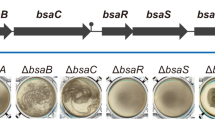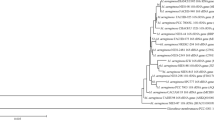Abstract
Polyhydroxyalkanoates (PHAs) are highly reduced bacterial storage compounds that increase fitness in changing environments. It has previously shown that polyhydroxybutyrate (PHB) accumulation is essential during the growth under cold conditions. In this work, the relationship between PHB accumulation and biofilm development at low temperature was investigated. P. extremaustralis, an Antarctic strain able to accumulate PHB, and its phaC mutant, impaired in the synthesis of this polymer, were used to analyze microaerobic growth, biofilm development, EPS content and motility. PHB accumulation increased motility and survival of planktonic cells in the biofilms developed by P. extremaustralis under cold conditions. Microaerobic conditions rescued the cold growth defect of the mutant strain. The PHB accumulation capability could constitute an adaptative advantage for the colonization of new ecological niches in stressful environments.



Similar content being viewed by others
References
Albesa I, Becerra MC, Battan PC, Paez PL (2004) Oxidative stress involved in the antibacterial action of different antibiotics. Biochem Biophys Res Commun 317:605–609
Ayub ND, Pettinari MJ, Méndez BS, López NI (2006) Impaired polyhydroxybutyrate biosynthesis from glucose in Pseudomonas sp. 14–3 is due to a defective beta-ketothiolase gene. FEMS Microbiol Lett 264:25–131
Ayub ND, Pettinari MJ, Méndez BS, López NI (2007) The polyhydroxyalkanoate genes of a stress resistant Antarctic Pseudomonas are situated within a genomic island. Plasmid 58:240–248
Ayub ND, Tribelli PM, López NI (2009) Polyhydroxyalkanoates are essential for maintenance of redox state in the Antarctic bacterium Pseudomonas sp. 14–3 during low temperature adaptation. Extremophiles 13:59–66
Branda SS, Ashild V, Friedman L, Kolter R (2005) Biofilms: the matrix revisited. Trends Microbiol 13:20–26
Bylund J, Burgess LA, Cescutti P, Ernst RK, Speert DP (2006) Exopolysaccharides from Burkholderia cenocepacia inhibit neutrophil chemotaxis and scavenge reactive oxygen species. J Biol Chem 281:2526–2532
Caiazza NC, Merritt HJ, Brothers JM, O’Toole GA (2007) Inverse Regulation of Biofilm Formation and Swarming Motility by Pseudomonas aeruginosa PA14. J Bacteriol 189:3603–3612
Chang WS, Li X, Halverson LJ (2009) Influence of water limitation on endogenous oxidative stress and cell death within unsaturated Pseudomonas putida biofilms. Environ Microbiol 11:1482–1492
Chattopadhyay MK, Raghu G, Sharma YV, Biju AR, Rajasekharan MV, Shivaji S (2011) Increase in oxidative stress at low temperature in an Antarctic Bacterium. Curr Microbiol 62:544–546
Chesson P, Gebauer RL, Schwinning S, Huntly N, Wiegand K, Ernest MS, Sher A, Novoplansky A, Weltzin JF (2004) Resource pulses, species interactions, and diversity maintenance in arid and semi-arid environments. Oecologia 141:236–253
Cochran WL, McFeters GA, Stewart PS (2001) Reduced susceptibility of thin Pseudomonas aeruginosa biofilms to hydrogen peroxide and monochloramine. J Appl Microbiol 88:22–30
Costerton J, Lewandowski Z, Caldwell D, Korber D, Lappin-Scot H (1995) Microbial biofilms. Annu Rev Microbiol 49:711–745
D’Amico S, Collins T, Marx JC, Feller G, Gerday C (2006) Psychrophilic microorganisms: challenges for life. EMBO Rep 7:385–389
Decho AW (2000) Microbial biofilms in intertidal systems: an overview. Cont Shelf Res 20:1257–1273
Donlan G (2002) Biofilms: microbial life on surfaces. Emerg Infec Dis 8:881–890
Hazer B, Steinbüchel A (2007) Increased diversification of polyhydroxyalkanoates by modification reactions for industrial and medical applications. Appl Microbiol Biotechnol 74:1–12
Kadouri D, Jurkevitch E, Okon Y, Castro-Sowinski S (2005) Ecological and agricultural significance of bacterial polyhydroxyalkanoates. Crit Rev Microbiol 31:55–67
Klausen M, Heydorn A, Ragas P, Lambertsen L, Aaes-Jørgensen A, Molin S, Tolker-Nielsen T (2003) Biofilm formation by Pseudomonas aeruginosa wild type, flagella and type IV pili mutants. Mol Microbiol 48:1511–1524
Kohler T, Curty LK, Barja F, van Delden C, Pechere JC (2000) Swarming of Pseudomonas aeruginosa is dependent on cell-to-cell signalling and requires flagella and pili. J Bacteriol 182:5990–5996
Lapaglia C, Hartzell PL (1997) Stress-induced production of biofilm in the hyperthermophile Archaeoglobus fulgidus. Appl Environ Microbiol 63:3158–3163
López NI, Floccari ME, Garcia AF, Steinbüchel A, Mendez BS (1995) Effect of poly-3-hydroxybutyrate content on the starvation survival of bacteria in natural waters. FEMS Microbiol Ecol 16:95–101
López NI, Pettinari MJ, Stackebrandt E, Tribelli PM, Pötter M, Steinbüchel A, Méndez BS (2009) Pseudomonas extremaustralis sp. nov. A poly(3-hydroxybutyrate) producer isolated from an Antarctic environment. Curr Microbiol 59:514–519
Lüthi E, Mercenier A, Haas D (1986) The arcABC operon required for fermentative growth of Pseudomonas aeruginosa on arginine: TnS-751-assisted cloning and localization of structural genes. J Gen Microbiol 132:2667–2675
Mah TF, O’Toole GA (2001) Mechanisms of biofilm resistance to antimicrobial agents. Trends Microbiol 9:34–39
Martinez P, Guzman J, Espin G (1997) A mutation impairing alginate production increased accumulation of poly-β-hydroxybutyrate in Azotobacter vinelandii. Biotech Lett 19:909–912
Matz C, Kjelleberg S (2005) Off the hook—how bacteria survive protozoan grazing. Trends Microbiol 13:302–307
Ostle A, Holt JG (1982) Nile Blue A as a fluorescent stain for polyhydroxybutyrate. Appl Environ Microbial 44:238–241
O’Toole GA, Kolter R (1998) Flagellar and twitching motility are necessary for Pseudomonas aeruginosa biofilm development. Mol Microbiol 30:295–304
Pessi G, Haas D (2000) Transcriptional control of the hydrogen cyanide biosynthetic genes hcnABC by the anaerobic regulator ANR and the quorum-sensing regulators LasR and RhlR in Pseudomonas aeruginosa. J Bacteriol 182:6940–6949
Pham TH, Webb JS, Rehm BHA (2004) The role of polyhydroxyalkanoate biosynthesis by Pseudomonas aeruginosa in rhamnolipid and alginate production as well as stress tolerance and biofilm formation. Microbiology 150:3405–3413
Pratt LA, Kolter R (1998) Genetic analysis of Escherichia coli biofilm formation: roles of flagella, motility, chemotaxis and type I pili. Mol Microbiol 30:285–293
Quelas JI, López-García SL, Casabuono A, Althabegoiti MJ, Mongiardini EJ, Pérez-Giménez J, Couto A, Lodeiro AR (2006) Effects of N-starvation and C-source on Bradyrhizobium japonicum exopolysaccharide production and composition, and bacterial infectivity to soybean roots. Arch Microbiol 186:119–128
Ren Q, de Roo G, Witholt B, Zinn M, Thöny-Meyer L (2010) Influence of growth stage on activities of polyhydroxyalkanoate (PHA) polymerase and PHA depolymerase in Pseudomonas putida U. BMC Microbiol 10:254
Sauer K, Camper AK, Ehrlich G, Costerton JW, Davies DG (2002) Pseudomonas aeruginosa displays multiple phenotypes during development as a biofilm. J Bacteriol 184:1140–1154
Shrout JD, Chopp DL, Just CL, Hentzer M, Givskov M, Parsek M (2006) The impact of quorum sensing and swarming motility on Pseudomonas aeruginosa biofilm formation is nutritionally conditional. Mol Microbiol 62:1264–1277
Simpson JA, Smith SE, Dean RT (1989) Scavenging by alginate of free radicals released by macrophages. Free Radical Biol Med 6:347–353
Strocchi M, Ferrer M, Timmis KN, Golyshin PN (2006) Low temperature-induced systems failure in Escherichia coli: insights from rescue by cold-adapted chaperones. Proteomics 6:193–206
Trevelyan WE, Harrison JS (1952) Studies on yeast metabolism. Fractionation and microdetermination of cell carbohydrates. Biochem J 50:298–303
Tribelli PM, Méndez BS, López NI (2010) Oxygen sensitive global regulator, Anr, is involved in biosynthesis of poly-3-hydroxybutyrate (PHB) in Pseudomonas extremaustralis. J Mol Microbiol Biotech 19:180–188
Van Alst N, Picardo K, Iglewski B, Haidaris C (2007) Nitrate sensing and metabolism modulate motility, biofilm formation, and virulence in Pseudomonas aeruginosa. Infect Immun 75:3780–3790
Wai S, Mizunoe Y, Takade A, Kawabata SI, Yoshida SI (1998) Vibrio cholerae O1 strain TSI-4 produces the exopolysaccharide materials that determine colony morphology, stress resistance, and biofilm formation. Appl Environ Microbiol 64:3648–3655
Wang H, Jiang X, Mu H, Liang X, Guan H (2007) Structure and protective effect of exopolysaccharide from P. agglomerans strain KFS-9 against UV radiation. Microbiol Res 162:124–129
Xu KD, Stewart PS, Xia F, Huang CT, McFeters GA (1998) Spatial physiological heterogeneity in Pseudomonas aeruginosa biofilms is determined by oxygen availability. Appl Environ Microbiol 64:4035–4039
Acknowledgments
This work was supported by grants from UBA and ANPCyT. N.I.L. is a career investigator from CONICET. P.M.T. has a graduate student fellowship from CONICET. We thank Karl G. Rueggeberg for his useful comments and language revision.
Author information
Authors and Affiliations
Corresponding author
Additional information
Communicated by A. Driessen.
Rights and permissions
About this article
Cite this article
Tribelli, P.M., López, N.I. Poly(3-hydroxybutyrate) influences biofilm formation and motility in the novel Antarctic species Pseudomonas extremaustralis under cold conditions. Extremophiles 15, 541 (2011). https://doi.org/10.1007/s00792-011-0384-1
Received:
Accepted:
Published:
DOI: https://doi.org/10.1007/s00792-011-0384-1




